Application of seismic attribute analysis to study fractured basement
04:29 |
07/11/2018
Lượt xem:
6525
Nguyen Thanh Tung(1), Pham Dinh Tan(1), Phan Thien Huong(2)
1.Vietnam Petroleum Institute,
2.Hanoi University of Mining and Geology
Email: tungnt@vpi.pvn.vn
Summary
Seismic attribute analysis is supposed to have a great potential to reveal latent geological features and has been implemented extensively in Cuu Long basin to predict the fractured reservoirs of the basement, however, the results so far have not been up to expectations. In this paper, previous seismic attribute studies are reviewed to show that the low signal to noise ratio (SNR) and the presence of artefacts are the main causes of inaccuracies or even misleading interpretations. To improve the effectiveness of seismic attributes in prediction of fractured reservoirs, three approaches to reduce the influence of noise and artefacts are proposed. The simplest way is to focus on the top basement surface instead of the section below it. A selective combination of independent attributes is used to delineate fault traces and anomalous zones related to rough boundaries on the top basement. To utilise the information inside the basement, principal component analysis (PCA) can be employed to separate noise and artefacts from the useful data. Ultimately, it is possible to increase the SNR in the processing stage with diffraction imaging technique. The processed data then can be analysed by seismic attributes or overlaid on conventional data to aid the interpretation of subtle faults and fractures..
Key words: Seismic attributes, principle component analysis, diffraction imaging, fractured basement, Cuu Long basin.
1. Introduction
Fractured basement is the most important reservoir rocktypein Cuu Longbasin, offshoreVietnamwithover 200 million tons of crude oil produced to date from this target alone. Nevertheless, after over 30 years of production, the prediction of fracture systems in the basement remains a great challenge for exploration and production activities. Since there are no clear reflection signals inside the basement, seismic attribute analysis is often applied to aid interpretation with an attempt to extract useful information for fault and fracture characterisation. In the last two decades many seismic attribute techniques have been implemented for basement targets in the basin, however after drilling results it often turned out that many of the predictions by seismic attributes have been inaccurate or even incorrect [1 - 3]. In this paper the applications of seismic attributes for basement reservoir characterisation in Cuu Long basin are reviewed by collecting information from major oil fields including Bach Ho, Rong, Ca Ngu Vang, Ruby, Diamond, Topaz, Hai Su Den, Su Tu Den, and Su Tu Vang. With lessons learned from the review, suitable approaches of seismic attribute analysis are proposed to target outstanding issues, thus making seismic attributes more effective for prediction of faults and fractures.
2. Review of previous results
In the early time of seismic attribute applications for basement reservoirs of Cuu Long basin, many “successful cases” have been demonstrated and published. The most well-known example of those probably is the case of Su Tu Den field in Block 15-1, where ant-tracking seismic attributes [4, 5] were used in combination with control beam migration (CBM) processed data [6, 7] to predict faults and fractures inside the basement. Figure 1 shows how ant-tracking attribute was applied to delineate lineaments on a time slice cut through the basement. On cross sections, these distinctive lineaments are steep- dip events that were enhanced by CBM technique and clearly delineated by ant-tracking attribute (Figure 2). With these “successful cases”, CBM and seismic attributes such as ant-tracking, coherence, curvature [8 - 10] quickly became popular tools for predicting faults and fractures inside the basement and have been widely applied in all blocks with basement targets such as 09/1,01-02, 15-1/05, 16/1, etc. The applications of CBM and seismic attributes were extensively implemented in the basement of Hai Su Den field of Block 16-1/05 where faults, domains, fracture zones and well designs were all defined with the help of CBM processed data and their seismic attributes [1]. Figure 3 demonstrates that with CBM technique, faults and fracture zones can be straightforwardly delineated on AI time slices and anomalies of variance attribute at 550ms below the top basement.
In other blocks, seismic attributes were also employed as a handy tool for basement assessment, and the most common attributes were RMS amplitude, AI, coherence, variance and ant-tracking. For example, in Block 01-02 [3], various seismic attributes were used to predict the fractured zones as demonstrated in Figure 4 where coherence and AI horizon slices at 400ms below the top basement indicating anomalous areas interpreted as faults and high fractured zones.
Apparently, the fault and fracture predictions shown above seem convincing, however, it was gradually realised by drilling results that the attribute anomalies inside the basement are not always coincident with faults or fractures. The more well information we have the more difficult it is to match attribute anomalies with fracture zones. A good example is the case of well- known Bach Ho and Rong fields of Block 09-1 [12, 13] which are by far the biggest fracture basement reservoirs in Cuu Long basin. The basement in these fields has been penetrated by hundreds of wells and it shows that many areas with attribute anomalies appear to have no fractures and vice versa. The ant-tracking cross section in Figure 5 across Rong field shows the inconsistency between the ant-tracking attribute and fractures measured by well data.
Figure 1. Faults can be nicely identified and tracked on a depth slice using ant-tracking attribute in Su Tu Den structure.
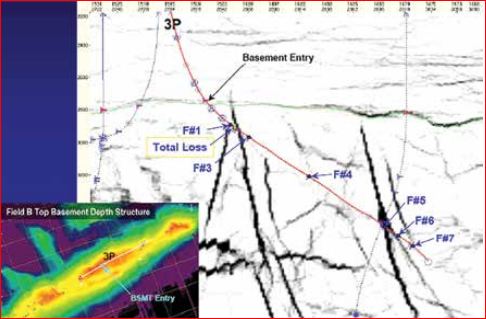 |
| (a) |
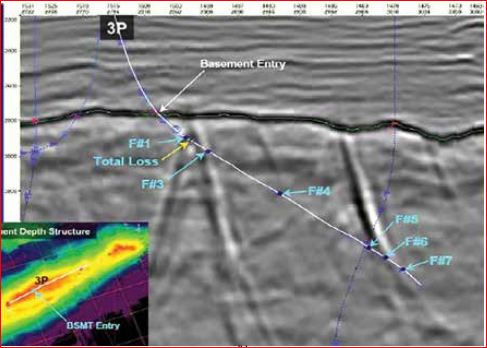 |
| (b) |
Figure 2. The faults (if real) on ant-tracking attribute (a) can also be observed on conventional seismic data (b).
The explanation for these inconsistencies was the low signal to noise ratio (SNR), since there are no refection boundaries inside the basement. The information only comes from diffractions at fault planes or fracture zones that are usually weak and much more difficult to image. ANN in combination with seismic attributes was also employed in Bach Ho field [13] in order to try to extract more consistent information but the results were still mixed, as it matches in some areas and does not match in others.
Beside the problem with noise, it was realised that artefacts also potentially cause pitfalls. Some of the previous “successful cases” turned out to be inaccurate or even misleading due to the false lineaments inside the basement generated by CBM technique. For example, some wells drilled into the “fractured zones” and crossing the “faults” predicted by seismic attributes of CBM data in Hai Su Den field were not actually penetrating fractures or faults as expected (Figure 3). The operating company now mainly relies on well information and surface signatures to design the wells, and attributes are for reference only [1]. Similarly, in other fields seismic attributes are no longer employed as the key tool to determine fractures inside the basement but only for qualitative reference.
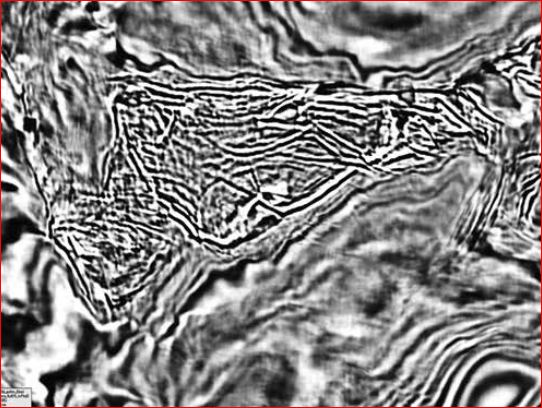 |
| (a) |
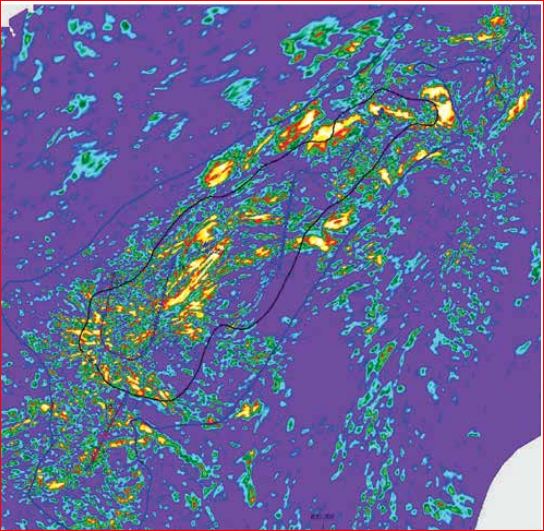 |
| (b) |
Figure 3. AI time slice (a) and variance attributes at 550m below the top basement (b) of CBM cube used to predict faults and fracture zones inside the basement.
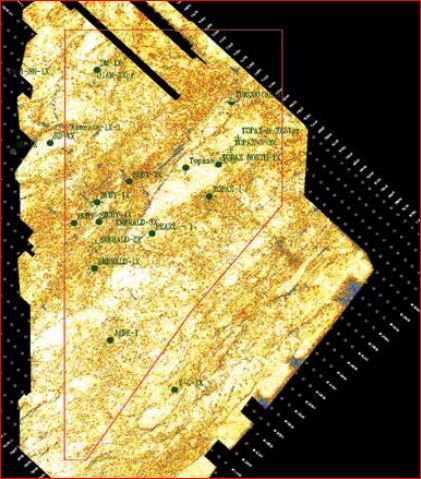 |
| (a) |
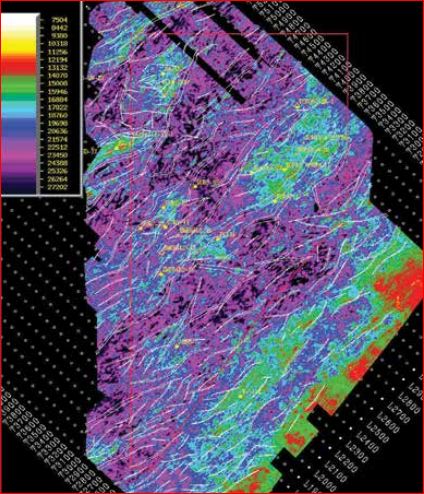 |
| (b) |
Figure 4. Coherency (a) and AI (b) horizon slices at 400ms below the top basement in Block 01-02.
A lesson learned from the review of previous studies is that although seismic attributes can be a great source of information about basement characteristics, they are usually contaminated with noise and artefacts that may cause inaccurate or misleading interpretations. In the next sections potential techniques are proposed to mitigate the problems and enhance the usefulness of seismic data so that valuable information about basement properties can be reliably extracted.
3. Surface attributes
Seismic attributes along the top basement surface are obviously the simplest way to target the noise and artefact problems because the top basement reflection usually has high SNR thanks to the high acoustic impedance contrast with the overlaying sediments. It is also not affected by artefact lineaments that sometimes dominate the section below. In a scenario, when the SNR beneath the top basement is too low, the surface attributes are the only option for fault and fracture interpretation of basement properties such as the case of Ruman structure, Melut basin, South Sudan, which was previously studied by the authors. On seismic and attribute sections of Ruman structure (Figure 7) the data portion below the top basement has a chaotic pattern with no interpretable anomalies on both conventional and attribute sections. Apparently, faults or fractures cannot be defined with the seismic data inside the basement, fortunately, the seismic attributes along the top basement carry sensible geological information about the basement structure. The interpretation of geological events was implemented based on different combinations of independent attributes with 3D visualisation to enhance the reliability of the technique. In Figure 8, selected 3D displays of seismic attributes are shown to explain the prediction of fault system and fractured zones.
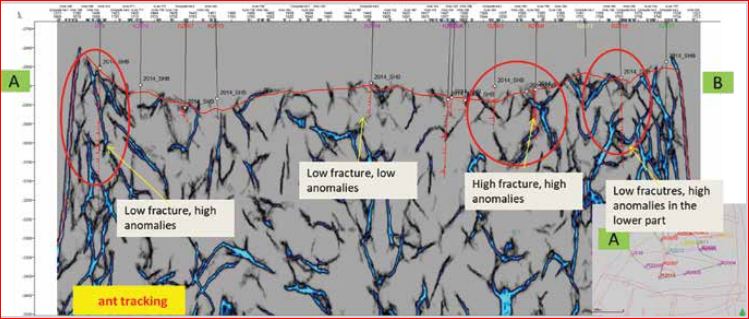 |
| |
Figure 5. Ant-tracking attribute anomalies are inconsistent with well data in Rong field.
Figure 6. Different attributes show no signature of faults inside the basement due to low SNR.
 |
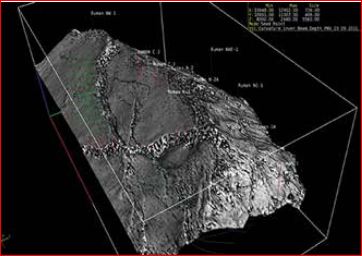 |
| (a) RMS amplitudes and dip & azimuth properties along the top basement. Strong reflec- tions are in blue, low reflectivity areas are in gray (marked as yellow dash ellipse). |
(b) Dip & azimuth and curvature properties along the top basement. Dark areas indicate rough surface. |
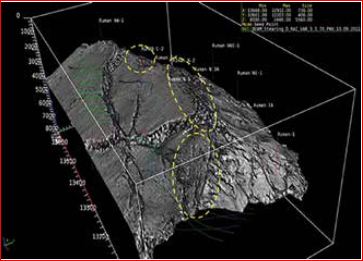 |
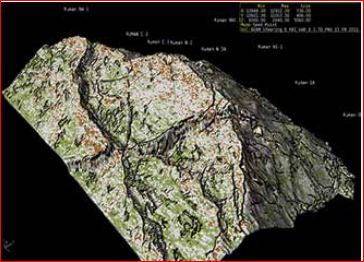 |
| (c) The same as (b) but overlaid by ant-tracking attribute that shows consistent features and enhances the subtle fault prediction. |
(d) Coherency and ant-tracking attributes at the top basement. Low coherency areas (displayed in green) well collocate with ant-tracking and RMS anomalies in (a) that indicate possible fracture zones.
|
Figure 7. Combination of different attributes extracted along the top basement horizon to aid the interpretation of subtle faults and fracture zones inside the basement.
Figure 8. Seismic cube (a); Fourth orthogonal component (b); Conventional ant-tracking shows random pattern while ant-tracking calculated using the fourth component (c); Emphasises the fracture network consistent with the fracture direction measured from wells (d).
Figure 9. Time slices at 3,400ms of four PCA components of a basement structure in Cuu Long basin show different characteristics that can be analysed with seismic attributes to predict the faults and fractures.
Figure 10. Seismic diffractions remain when reflections have been removed from the data (intermediate results at Vietnam Petroleum Institute).
The color scheme has been chosen to best demonstrate the geological features. Interestingly, subtle fault traces on the top basement that were unable to detect on conventional data (Figure 7) become apparent and consistent on surface attribute data (Figure 8).
Common independent attributes that are recommended to combine for interpretation of subtle faults are RMS amplitudes, dip & azimuth, curvature, coherency and ant-tracking. The interpretation is considered reliable if they give consistent signatures of fault traces and anomalous zones on the top basement surface. The RMS amplitude, dip & azimuth and curvature attributes are sensitive to surface rugosity while coherency, curvature and ant-tracking well respond to subtle faults [10, 11]. Other attributes such as variance, chaos, similarity, etc. can also be useful to combine to enhance the predictability providing that they are independent. Yet it should be noted that the surface attributes avoid the zones affected by noise and artefacts (i.e. below the top basement) thus on the other hand they also overlook the invaluable information contained within these zones.
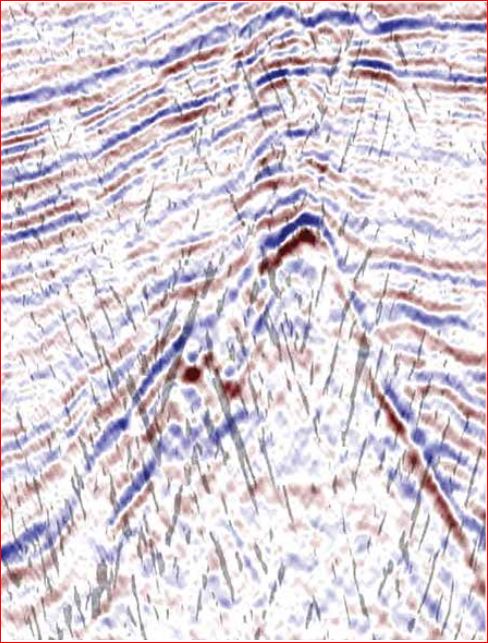 |
| |
Figure 11. Diffraction data (grey) overlaid with conventional seismic volume showing diffraction events imaging faults that are visible as terminations on the seismic horizons and inside the basements (intermediate results at Vietnam Petroleum Institute).
4. Principal component analysis
Principal component analysis (PCA) was introduced decades ago to aid the detection of subtle features on seismic data [14, 15]. Recently it becomes more popular on publications as a tool to separate artefact and noise from the latent features such as subtle faults and fractures [16, 17]. Generally, PCA decomposes the original seismic data into orthogonal components with uncorrelated properties, therefore noise, artefacts and latent responses from geological features can be separated into different component datasets. Well information is usually required to select an orthogonal component useful for fracture detection.
Priezzhev and Scollard [16] used 3D orthogonal decomposition of a seismic cube flattened along the target layer to detect fractures and subtle faults under strong noise conditions. The applied technique computes eigenvalues and eigenvectors of the 3D autocorrelation function of the original data to generate orthogonal 3D components that sum up very closely to the original cube. Figure
8 reproduced from [16] shows that the ant-tracking attribute of conventional seismic data (Figure 8a) has rather random pattern (Figure 8c) due to high noise level while the ant-tracking attribute of the PCA fourth component (Figure 8b) emphasises the fracture network consistent with the well information (Figure 8d).
Figure 12. Extractions along a target horizon, clockwise from top left: Raw diffraction volume (a); enhanced diffraction volume (b); positive and negative curvature volume (c); similarity volume (d).
The PCA technique has also been preliminarily tested by the authors for a basement structure in Cuu Long basin as illustrated in Figure 9 where PCA components show different characteristics that can be analysed with seismic attributes to predict the faults and fractures. As mentioned before, information from well data in the studied area must be used to calibrate with these components to enhance the credibility.
5. Diffraction imaging
The analysis techniques described in previous sections are to deal with seismic data that already contaminated by noise and artefacts. Diffraction imaging is a method thatincreases the SNR at the processing stage by focusing on diffracted responses from faults and fractures [18].
According to Benfield, et. al. [18], conventional seismic data are biased to the higher amplitude from clear continuous reflection events for structural interpretation when faults are interpreted as breaks in the reflection events. Diffraction imaging workflows aim to achieve the opposite, which is to attenuate the reflectors, leaving behind any focused diffraction events that may be owing to real geological phenomena such as faults, unconformities and depositional discontinuities. Figure 10 shows a seismic diffraction section with reflection signals removed, the data then can be processed in different ways to generate the diffraction volumes.
A seismic line through a basement structure in Cuu Long basin was initially processed at Vietnam Petroleum Institute using diffraction imaging technique provided by Emerson Paradigm as shown in Figure 11. The diffractions (grey lineaments) are overlaid on conventional reflection volume to show that faults indicated by the diffraction pattern well aligning with the seismic amplitude discontinuities. Additionally, there are diffraction lineaments that are parallel to the clearly imaged faults and go through the top basement. These can be interpreted as faults or fractures inside the basement revealed by the diffraction imaging technique.
Figure 12 reproduced from Benfield et al. [18] compares the diffraction data (Figures 12a and b) along a horizon with conventional post-stack attributes curvature (Figure 12c) and similarity (Figure 12d). Apparently, more lineation features are visible on the diffraction data but all three attributes consistently indicate a complex network of lineaments that can be interpreted as subtle faults and fractures. This diffraction imaging technique is therefore a promising tool to target the noise problems of the data portion beneath the top basement horizon.
6. Conclusions
In the last 20 years seismic attribute analysis has been widely applied to predict fault and fracture reservoir inside the basement in Cuu Long basin. A review of previous studies shows that although seismic attributes have great potential to reveal latent geological features of the basement, the very low signal to noise ratio (SNR) and the presence of artefacts can cause inaccurate or even misleading interpretations. This could be the main reason why in recent years seismic attribute analysis is much less applied for fractured basements than a decade ago.
To improve the effectiveness of seismic attributes in prediction of fracture reservoirs in the basement, three approaches to reduce the influence of noise and artefacts were proposed. The simplest way is to focus on the top basement surface instead of the section below it. A selective combination of independent attributes can be used to delineate fault traces and anomalous zones related to rough reflecting boundaries on the top basement. To utilise the information under the top basement, principal component analysis (PCA) can be employed to separate noise and artefacts from the data, in this case, well information is essential to verify the PCA component of use. Ultimately, the SNR in the basement can be increased directly during the data processing with diffraction imaging technique. The processed data can then be analysed by seismic attributes to predict fractures and faults or overlaid on conventional data to aid the interpretation.
References
1. PVN. Reserve assessment report of Hai Su Den - Hai Su Trang fields, Block 15-02/1. 2015.
2. PVN. Reserve assessment report of Ruby - Diamond - Topaz fields, Block 01&02. 2013.
3. PVN. Reserve assessment report of Su Tu Den - Su Tu Vang fields, Block 15-1. 2015.
4. Stein Inge Pedersen, Trygve Randen, Lars Sonneland, Øyvind Steen. Automatic fault extraction using artificial ants. SEG Technical Program Expanded Abstracts. 2002: p. 512 - 515.
5. Tom Cox, Krista Seitz. Ant tracking seismic volumes for automated fault interpretation. 2007 CSPG/CSPE GeoConvention, Calgary, Alberta, Canada. 14 - 17 May, 2007.
6. G.Bone, N.T.Giang, D.N.Quy, V.N.An, D.Pham, J.Sun, Q.Tang. Improvements in seismic imaging in fractured basement, Block 15-1, offshore Vietnam. Fractured Basement Reservoir, Petrovietnam. 2008; 4: p. 63 - 69.
7. Don Pham, Jason Sun, James Sun, Qingbing Tang, Graeme Bone, Nguyen Truong Giang. Imaging of fractures and faults inside granite basement using controlled beam migration. ASEG Extended Abstracts. 2007; 1: p. 1 - 5.
8. Saleh Al-Dossary, Kurt J.Marfurt. 3D volumetric multispectral estimates of reflector curvature and rotation. Geophysics. 2006; 71(5): p. 41 - 51.
9. P.Scholtz. Coherence calculation of different seismic attribute traces for fault interpretation. European Association Of Geophysical Exploration. 1996; 61: p. 65.
10. Satinder Chopra, Kurt J.Marfurt. Seismic attributes for fault/fracture characterization. SEG Technical Program Expanded Abstracts. 2007: p. 1520 - 1524.
11. E.J.H.Rijks, J.C.E.M.Jauffred. Attribute extraction: An important application in any detailed 3-D interpretation study. The Leading Edge. 1991; 10(9): p. 11 - 19.
12. PVN. Reserve assessment report of Rong field, Block 09-1. 2014.
13. PVN. Reserve assessment report of Bach Ho field, Block 09-1. 2017.
14. David C.Hagen. The application of principal components analysis to seismic data sets. Geoexploration. 1982; 20(1-2): p. 93 - 111.
15. J.R.Scheevel, K.Payrazyan. Principal component analysis applied to 3D seismic data for reservoir property estimation. SPE Reservoir Evaluation & Engineering. 1999; 4(1): p. 64 - 72.
16. Ivan Priezzhev, Aaron Scollard. Fracture detection through seismic cube orthogonal decomposition. Society of Exploration Geophysicists (SEG) Technical Program Expanded Abstracts. 2013: p. 1308 - 1313.
17. Poorandokht Soltani, Mehrdad Soleimani, Hamid Aghajani. Faults and fractures detection in 2D seismic data based on principal component analysis. International Journal of Mining and Geo-engineering. 2017; 51(2): p. 199 - 207.
18. N.R.Benfield, A.Guise, D.Chase. Diffraction imaging - a tool to reduce exploration and development risk. First Break. 2016; 34(3): p. 57 - 63.
Bình luận
